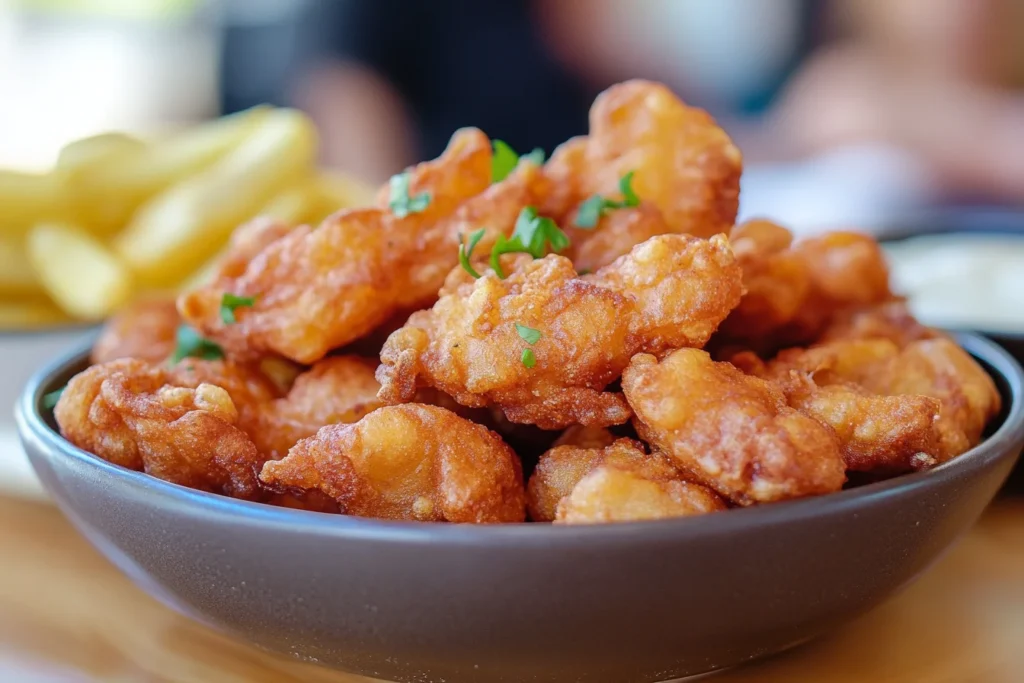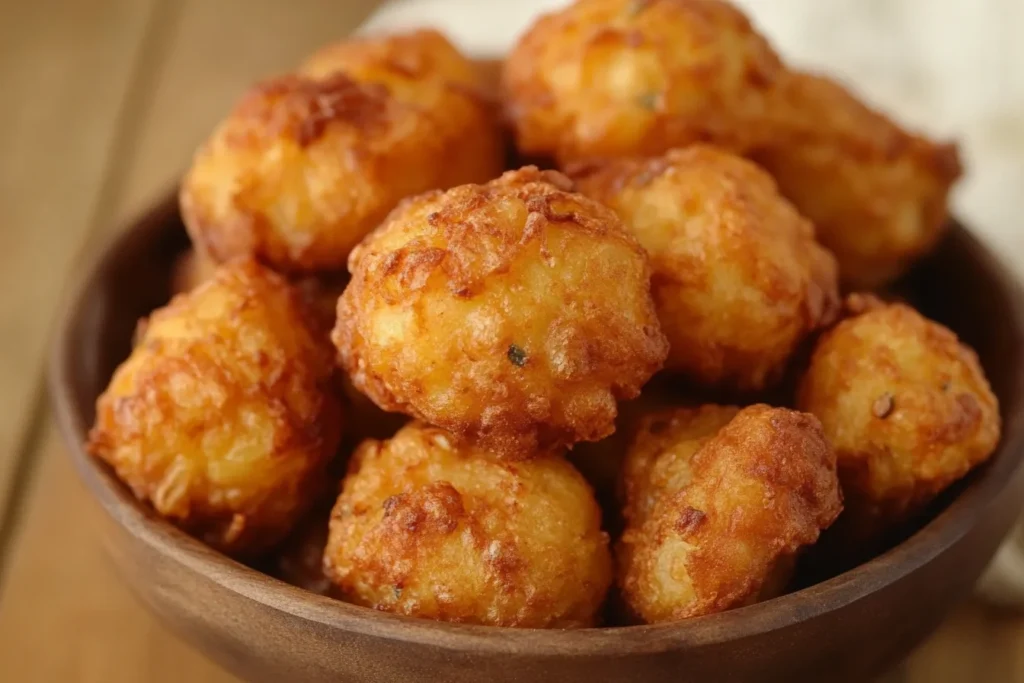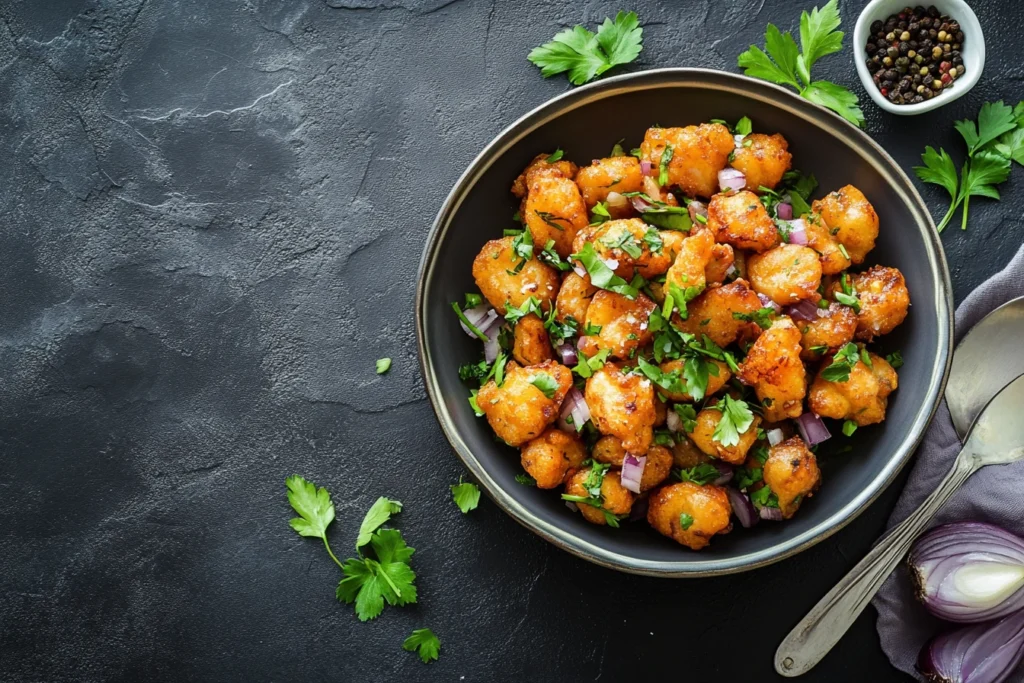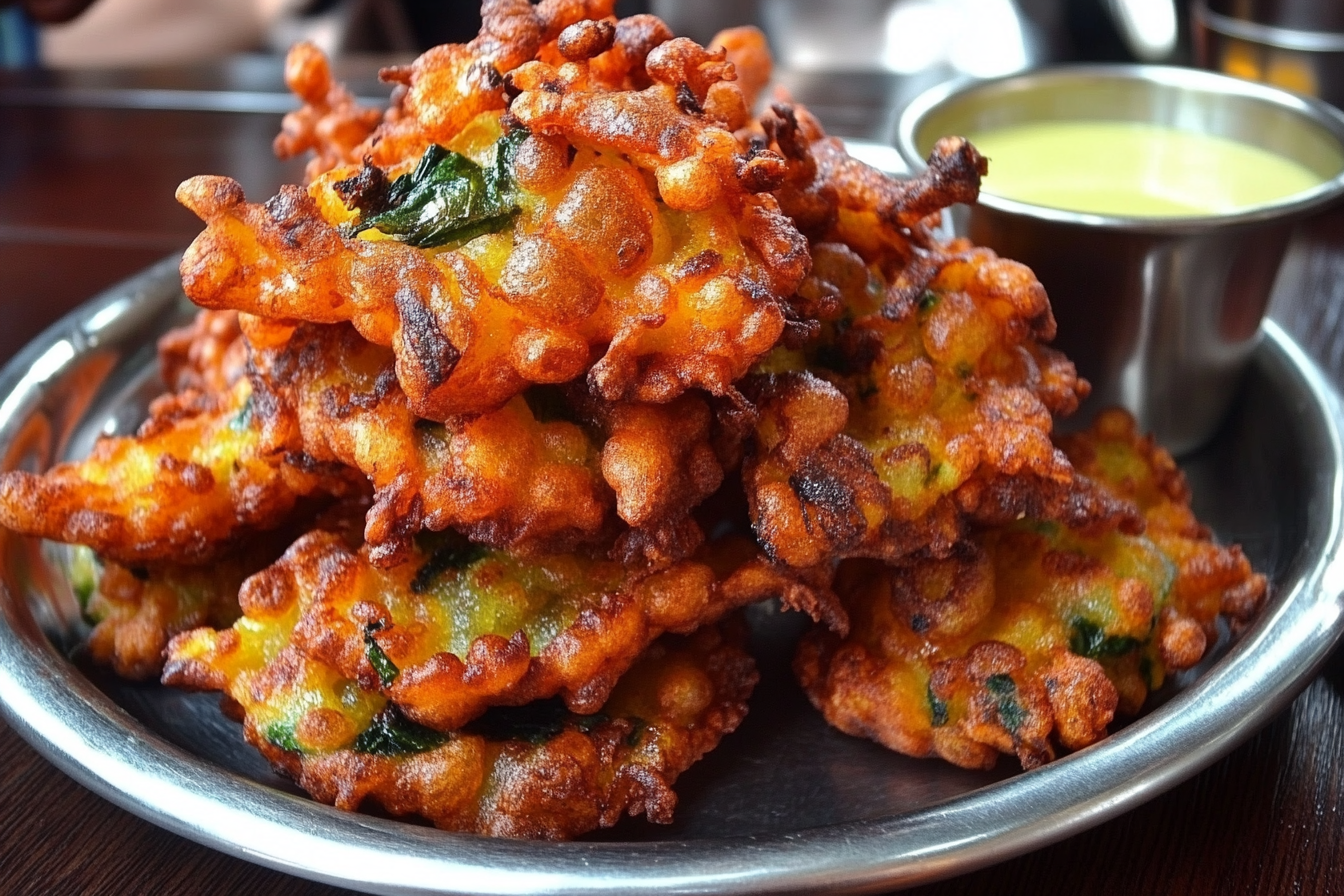H1: Introduction to Onion Pakoda
Onion Pakoda, also known as Onion Bhaji, is a popular Indian snack made from thinly sliced onions coated in a spiced gram flour batter and deep-fried to crispy perfection. This delicacy holds a special place in Indian households, often served with tea or during festive gatherings. Its popularity stems from its delightful crunch, savory flavors, and the nostalgia it evokes.
Whether enjoyed during a rainy evening or as a street food indulgence, Onion Pakoda is cherished for its simplicity and versatility. Its easy preparation and delicious taste have made it a beloved snack not just in India but globally, where it is often associated with Indian cuisine.
H2: Ingredients of Onion Pakoda
The foundation of Onion Pakoda lies in its simple yet flavorful ingredients:
- Onions: Thinly sliced onions are the star, providing the signature flavor and texture.
- Gram Flour (Besan): The batter base that binds the onions together and gives a nutty taste.
- Rice Flour: Optional but enhances the crispiness.
- Spices: Turmeric, red chili powder, and carom seeds (ajwain) add color, heat, and aroma.
- Salt: Brings out the flavors.
- Water: Helps create a smooth batter for coating.
- Oil: Used for deep-frying, ensuring a golden, crunchy finish.
These basic ingredients can be customized by adding herbs like coriander leaves or green chilies for a unique twist.
H3: Cooking Method of Onion Pakoda
The traditional preparation of Onion Pakoda involves deep-frying, which creates its iconic texture and flavor.
Steps:
- Mix gram flour, spices, and water to form a thick batter.
- Add thinly sliced onions, ensuring they are well-coated.
- Heat oil in a deep pan. Once hot, drop spoonfuls of the onion-batter mixture into the oil.
- Fry until golden brown and crisp, then drain on a paper towel to remove excess oil.
Health Impact:
While deep-frying makes the pakodas crispy and delicious, it also increases their calorie content due to oil absorption. Moderation is key to balancing enjoyment and health.

H4: Nutritional Composition of Onion Pakoda
The nutritional profile of Onion Pakoda depends on the preparation method and portion size. On average, a serving of 100g provides:
- Calories: ~300-350 kcal
- Carbohydrates: ~35-40g
- Fats: ~15-20g (varies with frying oil quality)
- Protein: ~5-7g
Nutritional Insights:
- Carbs and Fats: High levels contribute to energy but also require portion control.
- Protein: Moderate due to gram flour, making it more nutritious than typical fried snacks.
- Onions: Provide fiber, antioxidants, and vitamins, adding health value to the snack.
H5: Traditional Role of Pakodas in Indian Cuisine
Onion Pakoda is more than a snack; it’s a cultural emblem in India. Its simplicity and universal appeal have made it a staple during:
- Festivals: Pakodas are often served alongside sweets during celebrations like Diwali and Holi.
- Family Gatherings: A quick and easy dish to bring people together.
- Street Food Culture: Sold by vendors in every corner of India, adding to its accessibility and charm.
This snack bridges regional and social divides, symbolizing the warmth and hospitality of Indian culture.
H6: Occasions for Enjoying Onion Pakoda
From cozy monsoon evenings to festive celebrations, Onion Pakoda fits every occasion:
- Monsoon Delight: Best enjoyed with a steaming cup of tea on a rainy day.
- Tea-Time Treat: A staple accompaniment for evening chai.
- Festive Spread: Complements the grandeur of Indian festivals.
- Quick Comfort Food: Ideal for satisfying sudden hunger pangs or unexpected guests.
Its versatility ensures it remains a beloved choice for every season and setting.
H7: Variants of Onion Pakoda
While the classic version is loved by all, there are exciting regional and modern twists to explore:
- South Indian Venkaya Bajji: Features a slightly spicier batter with curry leaves.
- Street-Style Onion Pakoda: Extra crispy with bold seasoning, served in paper cones.
- Healthy Variants: Includes baking or air-frying for reduced fat content.
Each variant brings a unique taste and texture, proving that Onion Pakoda is endlessly adaptable.
H8: The Allure of Fried Foods
Why are fried snacks like Onion Pakoda so irresistible?
- Crispy Texture: The crunch provides a satisfying eating experience.
- Enticing Aroma: Spices and frying release an unforgettable fragrance.
- Flavor Burst: Each bite combines spices, onions, and the umami of fried batter.
- Comfort Factor: Fried foods evoke nostalgia and warmth, making them deeply satisfying.
While indulgent, fried snacks like pakodas can be enjoyed mindfully for maximum pleasure.
H9: Pakodas and Street Food Culture
Onion Pakoda holds a prominent spot in India’s vibrant street food scene. Found in bustling markets and roadside stalls, it offers:
- Affordability: A budget-friendly snack for all.
- Quick Preparation: Served fresh and hot within minutes.
- Social Experience: Often enjoyed with friends and family amidst lively street settings.
This iconic snack contributes to the rich tapestry of Indian street food, embodying its flavors and traditions.
H10: Misconceptions About Onion Pakoda
Despite its popularity, Onion Pakoda is surrounded by misconceptions:
- “Too Unhealthy”: While deep-fried, it offers nutritional benefits from onions and spices.
- “Difficult to Make”: A straightforward recipe makes it accessible to even novice cooks.
- “Only for Rainy Days”: Pakodas are versatile enough for any occasion, rain or shine.
Understanding these facts helps appreciate Onion Pakoda as a delicious and culturally significant snack.

Part 2: Health Impact of Onion Pakoda
H1: Is Onion Pakoda Unhealthy?
The question of whether Onion Pakoda is unhealthy is common. While it’s undeniably delicious, its nutritional profile depends on the preparation method, ingredients, and portion size.
Pros:
- Nutritious Ingredients: Onions, gram flour, and spices offer vitamins, minerals, and antioxidants.
- Quick Energy Source: The carbohydrate content makes it a good snack for immediate energy.
Cons:
- High Calorie Content: Deep-frying increases calories, making it a calorie-dense snack.
- Oil Absorption: Poor frying techniques can lead to excess oil, increasing fat content.
Verdict:
Onion Pakoda can be part of a balanced diet when consumed in moderation and paired with healthier preparation methods.
H2: Effects of Deep-Frying
Deep-frying is essential for the crispy texture of Onion Pakoda, but it significantly impacts its health quotient:
Downsides:
- Nutrient Loss: Heat-sensitive vitamins in onions and spices may degrade.
- Increased Calories: Frying adds 30–50% more calories compared to baking.
- Trans Fats: Reusing oil can produce unhealthy trans fats.
Mitigation Tips:
- Use fresh oil and avoid repeated heating.
- Opt for oils with high smoke points, such as sunflower or rice bran oil.
- Limit portion sizes to control calorie intake.
H3: Fat Content in Onion Pakoda
The type and amount of fat in Onion Pakoda depend on the oil used for frying:
- Types of Fat: Quality oils contain healthier unsaturated fats, but deep-frying can introduce saturated or trans fats.
- Amount of Fat: A single serving of Onion Pakoda (~100g) can have 15-20g of fat.
Health Implications:
- High fat content can contribute to weight gain if consumed excessively.
- Using oils like olive or avocado oil can reduce the risk of unhealthy fat intake.
H4: High Calorie Density of Pakodas
The calorie density of Onion Pakoda is a key factor in its indulgent nature:
- Calories per Serving: A small portion (~6 pieces) can contain 300-400 kcal.
- Impact on Weight: Regular consumption without portion control can lead to excess calorie intake.
Portion Control Tips:
- Use smaller serving sizes to reduce calorie consumption.
- Pair pakodas with a fresh salad or soup for a more balanced meal.
H5: Glycemic Load and Carb Content
Onion Pakoda has a moderate glycemic load, meaning it can impact blood sugar levels:
- Carbohydrates: The gram flour batter and onions provide simple and complex carbs.
- Blood Sugar Impact: Eating large quantities can cause a spike in blood sugar.
Tips for Diabetics:
- Combine pakodas with high-fiber foods to slow down sugar absorption.
- Avoid adding sugar to the batter.
H6: Spices and Health Benefits
The spices in Onion Pakoda don’t just enhance flavor but also offer health benefits:
- Turmeric: Anti-inflammatory and boosts immunity.
- Ajwain (Carom Seeds): Aids digestion and reduces bloating.
- Red Chili Powder: Contains capsaicin, which may boost metabolism.
Pro Tip:
Adding fresh herbs like coriander can further enhance the nutritional profile.
H7: Onion’s Nutritional Benefits
The humble onion is a nutritional powerhouse, adding value to Onion Pakoda:
- Antioxidants: Rich in quercetin, which supports heart health.
- Fiber: Aids digestion and promotes gut health.
- Vitamins: Provides vitamin C and B6 for immune support and energy metabolism.
Even after frying, onions retain a portion of their health benefits, making Onion Pakoda more than just a guilty pleasure.
H8: Salt Content in Onion Pakoda
Salt is an essential ingredient in Onion Pakoda but can have implications for health:
- Sodium Levels: Excessive salt contributes to high blood pressure.
- Serving Control: A single serving can contain up to 400mg of sodium.
Tips for Reducing Sodium:
- Use a smaller amount of salt in the batter.
- Pair pakodas with low-sodium chutneys or dips.
H9: Comparing Homemade and Street Pakodas
The healthiness of Onion Pakoda varies significantly between homemade and street versions:
Homemade:
- Better Quality: Fresh oil and controlled ingredients.
- Customization: Can adjust spices, salt, and frying techniques.
Street Food:
- High Oil Usage: Often uses reused or low-quality oil.
- Hygiene Concerns: May not meet proper food safety standards.
Verdict:
Homemade pakodas are a healthier and safer option, especially for regular consumption.
H10: Moderation: The Key to Enjoying Pakodas
Onion Pakoda can be enjoyed guilt-free when consumed mindfully:
- Balance: Include it as part of a meal with fresh vegetables or lentil soup.
- Frequency: Limit to once a week or special occasions to avoid excessive calorie and fat intake.
- Portion Size: Stick to 3-4 pieces per serving to maintain a balanced diet.
By practicing moderation, you can relish the crispy goodness of Onion Pakoda without compromising your health.
Part 3: Making Onion Pakoda Healthier

H1: Choosing Healthier Oils for Frying
The type of oil used for frying significantly affects the healthiness of Onion Pakoda. Opting for better-quality oils can make a big difference.
Healthier Oil Options:
- Olive Oil: A heart-healthy option, though it’s best for shallow frying due to its low smoke point.
- Avocado Oil: Excellent for deep-frying due to its high smoke point and healthy fats.
- Coconut Oil: Adds a unique flavor and is stable at high temperatures.
- Peanut Oil: Commonly used in Indian cooking, it’s rich in monounsaturated fats.
Tips for Optimal Use:
- Use fresh oil for every batch to avoid trans fat formation.
- Avoid overheating oil, which can degrade its nutritional value.
H2: Air-Frying Onion Pakoda
Air-frying is a modern and healthier alternative to deep-frying, drastically reducing fat content without compromising crispiness.
Benefits of Air-Frying:
- Lower Fat Content: Uses only a fraction of the oil needed for deep-frying.
- Similar Texture: Achieves the signature crispiness of traditional pakodas.
- Convenience: Air fryers are easy to use and clean.
How to Air-Fry Onion Pakoda:
- Prepare the batter as usual.
- Preheat the air fryer to 180°C (356°F).
- Place spoonfuls of the batter-coated onions on the air fryer tray.
- Spray lightly with oil and cook for 10-15 minutes, flipping halfway.
This method ensures a healthier yet delicious version of Onion Pakoda.
H3: Baking Instead of Frying
Baking is another excellent alternative to deep-frying, particularly if you don’t own an air fryer.
Advantages of Baking:
- Minimal Oil Usage: Only a light brushing of oil is needed.
- Even Cooking: Provides consistent crispiness.
- Healthier Outcome: Reduces calorie content significantly.
Baking Method:
- Preheat the oven to 200°C (392°F).
- Place the batter-coated onions on a lined baking tray.
- Brush or spray with a small amount of oil.
- Bake for 20-25 minutes, flipping halfway to ensure even browning.
Baked Onion Pakoda retains its flavor while being a low-fat option.
H4: Adding Fiber-Rich Ingredients
Boosting the nutritional profile of Onion Pakoda is easy with the inclusion of fiber-rich ingredients.
Ingredient Substitutions:
- Whole-Grain Flour: Replace gram flour partially with whole-wheat or millet flour.
- Vegetables: Add shredded carrots, spinach, or cabbage to the batter for extra fiber.
- Chia Seeds or Flaxseeds: Mix these into the batter for added omega-3 fatty acids and fiber.
These additions not only enhance the health quotient but also bring unique flavors to your pakodas.
H5: Portion Control Tips
Enjoying spiced onion pakoras without overindulging requires mindful portion control.
Portion Management:
- Stick to 3-4 pakodas per serving.
- Use smaller-sized spoonfuls when frying to naturally reduce serving size.
- Pair pakodas with a hearty vegetable soup or salad to feel fuller with fewer pieces.
Mindful eating helps maintain balance and avoids overeating.
H6: Pairing Pakodas with Healthy Chutneys
Traditional chutneys can sometimes be high in sugar or salt, but healthier options can make a big difference.
Healthy Pairing Ideas:
- Mint Yogurt Chutney: Blend fresh mint, yogurt, and a pinch of cumin for a refreshing dip.
- Tamarind-Date Chutney: Use natural sweeteners like dates instead of refined sugar.
- Tomato-Garlic Chutney: A spicy, low-sodium option with fresh tomatoes and roasted garlic.
These pairings enhance flavor while balancing the richness of fried snacks.
H7: Frequency of Consumption
Balancing indulgence and health is all about how often you include spiced onion pakoras in your diet.
Recommendations:
- Limit to once a week or for special occasions.
- Opt for healthier preparation methods like air-frying or baking when enjoying more frequently.
- Avoid pairing pakodas with other high-calorie or fried foods in the same meal.
Moderating frequency ensures spiced onion pakoras remains a treat, not a dietary concern.
H8: Avoiding Refined Oils and Flours
Refined oils and flours can detract from the nutritional value of spiced onion pakoras.
Better Choices:
- Use cold-pressed oils to retain natural nutrients.
- Replace refined flours with alternatives like almond flour, chickpea flour, or oat flour.
By avoiding overly processed ingredients, you can make pakodas both healthier and tastier.
H9: Serving Onion Pakoda as Part of a Balanced Meal
Instead of treating Onion Pakoda as a standalone snack, integrate it into a balanced plate.
Meal Pairing Ideas:
- Serve alongside a lentil soup for added protein.
- Include a side of fresh vegetable salad to provide fiber and vitamins.
- Pair with a glass of spiced buttermilk to aid digestion and balance richness.
This approach ensures your meal is nutritionally complete while still including your favorite snack.
H10: Cultural Enjoyment Without Overindulgence
Onion Pakoda is deeply ingrained in Indian culture, from festive celebrations to family gatherings. Enjoying it mindfully allows you to savor its essence without health guilt.
Tips for Mindful Eating:
- Focus on the flavors and textures rather than eating quickly.
- Share pakodas with friends and family to avoid overindulgence.
- Combine indulgent foods like pakodas with healthier options during the same meal.
This balance helps you relish Onion Pakoda as a cultural delight while maintaining a healthy lifestyle.
FAQs About Onion Pakoda
- Can I make Onion Pakoda without deep-frying?
Yes, you can air-fry or bake Onion Pakoda for a healthier version. Both methods significantly reduce the fat content while retaining the crispy texture. - What is the best oil for frying Onion Pakoda?
Oils with high smoke points like peanut oil, rice bran oil, or avocado oil are ideal for frying as they are stable at high temperatures. - Can I make Onion Pakoda gluten-free?
Onion Pakoda is naturally gluten-free when made with gram flour (besan). Ensure no other ingredients with gluten are added. - How can I reduce the calorie content of Indian fried snack?
Use healthier cooking methods like baking or air-frying. Additionally, reduce the amount of batter used to coat the onions. - What spices can I add to enhance the flavor of Indian fried snack?
Popular spices include turmeric, red chili powder, ajwain (carom seeds), cumin, and coriander. You can also add finely chopped green chilies for extra heat. - Why is my Onion Pakoda not crispy?
Ensure the batter isn’t too watery, and fry the pakodas in oil at the correct temperature (medium heat). Overcrowding the frying pan can also lead to soggy pakodas. - How can I store leftover Indian fried snack?
Store in an airtight container and reheat in an oven or air fryer to restore crispiness. Avoid microwaving as it makes them soggy. - Can I make Indian fried snack vegan?
Onion Pakoda is naturally vegan as it uses no animal-based ingredients. Just ensure that any accompanying chutneys are vegan-friendly. - What chutney pairs best with Onion Pakoda?
Tamarind-date chutney, mint-coriander chutney, and garlic-tomato chutney are popular accompaniments. You can also serve it with yogurt-based dips for a refreshing contrast. - Is Indian fried snack safe for people with diabetes?
Onion Pakoda can cause a spike in blood sugar due to its carbohydrate content. To make it diabetic-friendly, pair it with high-fiber foods, limit portions, and avoid refined flours.

